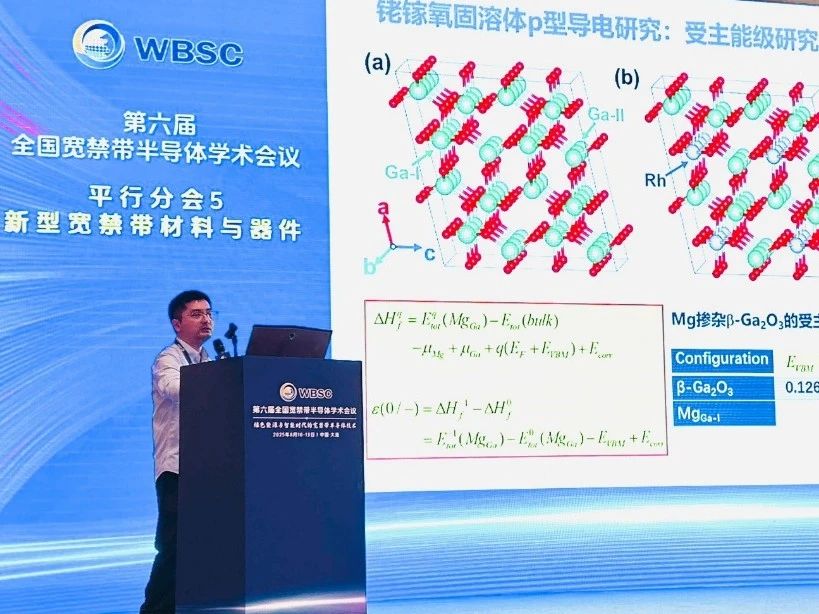
【Member News】Shenzhen Pinghu Laboratory Invited to Present Research Progress at the 6th National Wide Bandgap Semiconductor Conference
日期:2025-08-21阅读:13
Two research achievements from Shenzhen Pinghu Laboratory were presented as oral reports at the 6th National Wide Bandgap Semiconductor Conference held in Dalian, China. Prof. Zha Xianhu delivered a report titled “Research on the Regulation of Band Structure of β-Phase Gallium Oxide by Metal Solid Solution and P-type Conductivity of Solid Solutions”, and Prof. Zhang Rongjun presented “Research Progress on Aluminum Nitride Power Devices”. These presentations highlighted Shenzhen Pinghu Laboratory’s active exploration of frontier theoretical research in the field of ultra-wide bandgap semiconductors, bringing new ideas and vitality to the development of the industry.
The 6th National Wide Bandgap Semiconductor Conference was held in Dalian, China, from August 10 to 13. The conference featured extensive exchanges on topics including wide bandgap semiconductor material growth technologies, material structures and physical properties, the R&D of optoelectronic and electronic devices, as well as related equipment development. At the conference, two research achievements from Shenzhen Pinghu Laboratory were presented as oral reports, focusing respectively on the theoretical study of P-type conductivity in β-phase Gallium Oxide and the latest progress in Aluminum Nitride power device research. The report on the P-type conductivity of Gallium Oxide was delivered by Dr. Zha Xianhu, while the report on Aluminum Nitride power devices was presented by Dr. Zhang Rongjun. On the evening of August 11, Dr. Wan Yuxi, Director of Shenzhen Pinghu Laboratory, attended the second mid-term working meeting of the Wide Bandgap Semiconductor Professional Committee of the China Nonferrous Metals Society.

Report by Prof. Zha Xianhu
Prof. Zha Xianhu’s report, “Research on the Regulation of Band Structure of β-Phase Gallium Oxide by Metal Solid Solution and P-type Conductivity of Solid Solutions”, introduced the regulation rules of the band structure of β-phase gallium oxide under a single solid solution concentration with 49 different metal solid solutions. The band structure, potential P-type doping schemes, and hole mobility of β-phase rhodium Gallium Oxide solid solutions at different concentrations were analyzed in detail, indicating that β-phase rhodium Gallium Oxide solid solution is a promising wide bandgap metal oxide semiconductor capable of achieving P-type conductivity. This research is expected to promote the broad application of β-phase gallium oxide devices in areas such as power transportation and smart grids. In addition, the report highlighted that combining the SCAN functional with the HSE06 hybrid functional provides an effective approach for first-principles calculations of wide bandgap solid solutions.

Report by Prof. Zhang Rongjun
Prof. Zhang Rongjun’s report, “Research Progress on Aluminum Nitride Power Devices”, presented the latest research on Aluminum Nitride Schottky barrier diode (SBD) and high electron mobility transistor (HEMT) devices. The fabricated SBD devices exhibited reverse breakdown voltages exceeding 3 kV, with specific on-resistances of 62.5 Ω·cm² and 27.7 Ω·cm², respectively. For the fabricated HEMT devices, the breakdown voltages were 990 V and 2045 V at LGD values of 5 µm and 25 µm, respectively, and exceeded 3 kV at an LGD of 50 µm. The report also pointed out that aluminum nitride currently faces certain challenges in material growth, substrates, epitaxy, and device fabrication. Nevertheless, owing to its outstanding material properties, aluminum nitride power devices hold significant application prospects in smart grids, high-speed locomotives, and extreme environments in the future.
The recent research progress on Gallium Oxide and Aluminum Nitride shared by Shenzhen Pinghu Laboratory at the conference not only provided domestic peers and experts with a direct understanding of the synergy between the laboratory’s in-depth exploration of cutting-edge theories and its strong research capabilities, but also further enhanced the academic influence of Shenzhen Pinghu Laboratory.


